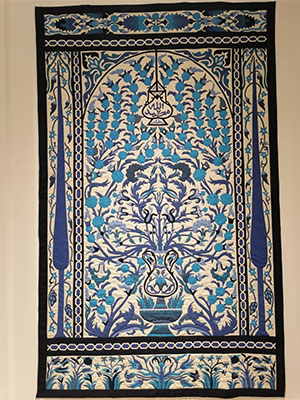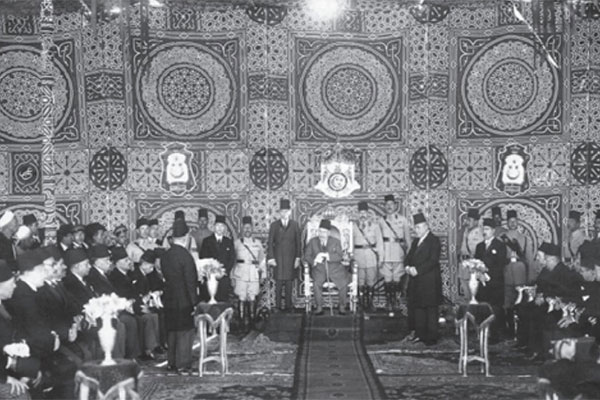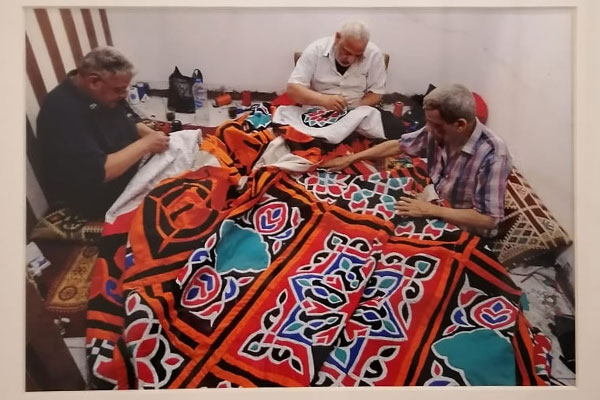At the premises of Ubuntu art gallery in Zamalek, the walls are covered with vibrant colours, geometrical patterns, and stories from the heart of historic Cairo. ‘Reimagined Memories’ is the name of the exhibition showcasing all the skillful art of khayamiya (Tent Makers), one of Egypt’s oldest handmade weaving art. Like a kaleidoscope, these khayamiya patterns reveal their share of Egypt’s intangible heritage in every stitch.
“The idea behind the name of the exhibition is to curate such traditional crafts in an untraditional way, so I thought of picking a variety of unique pieces that are old, new and also include paintings of artists that were inspired by the khayamiya,” explained Seif El-Rashidi, an art historian, director of the Barakat trust, and the curator of the exhibition.
“I found out that all of them are a response of a concept that they felt, and, like this piece, this is inspired by ancient Egyptian motifs. However, when you compare it with an ancient Egyptian wall painting, you will find that it is different. This is how it translates into a khayamiya.”
“It is expressed in a slightly different way, and so the ‘re-imagination’, is the creative part. A lot of designers think the khayamiya artists reproduce the same art with no newness. Actually, I do not think that it is true. I see that the craftsmen themselves say that they want to make borders with different integrated colours. There is a creative process of thinking in a new way, about what I can do that catches the attention,” explained El-Rashidi to Ahram Online.

Photo credit to Amira Noshokaty.
Exactly how old is khayamiya art?
“Cairo is the creative centre for khayamiya, and its main market. However, the idea of sewing two different types of fabrics, especially on leather, is found in ancient Egypt as well in other countries or regions like India, South America, and even the Ottoman Empire.”
“However, the idea of Egyptian khayamiya came from the ceremonial tents of the Fatimid, Mamluk, and Ottoman empires, whose tents were made out of khayamiya. They made ceremonial tents or curtains with vibrant colours that reflect joy and grandeur to impress their guests,” he explained.
According to The Tentmakers of Cairo (AUC Press 2018), a book by Seif El-Rashidi and Sam Bowker:
‘Khayamiya are used in Egypt in two main forms. The first is as an architectural textile —literally tents— ranging from mammoth rectangular pavilions (suradiq or siwan) used to host ceremonial events such as weddings, feasts, and funerals, to single-poled camping tents (singular fustat) used by travelers, particularly tourists. The second form of khayamiya is individual panels (singular tark), which can also take the form of screen like bands or tent walls. This is the most significant form today because it produces quilt-like artworks for interior display rather than cumbersome ephemeral buildings. Both forms of khayamiya in the late nineteenth century regularly featured Arabic epigrams.

Photo courtesy Seif El-Rashidi.
“If you are the Mamluk Sultan and you want to celebrate Mulid Al-Naby (The Prophet’s Birthday), you do not want to celebrate in the palace; you want to celebrate in a public place that has room for thousands. So, you make a tent in the middle of Citadel square, and when you do this, you can put up your tent, three days in advance of the event, where the public would come and marvel at the beauty of the tent of the sultan, for the khayamiya represented the state,” noted El-Rashidi.

Photo credit to Amira Noshokaty.
Durability, visibility, and perspective are the main aspects of khayamiya craft.
“I think it has a very long history in technique, but what’s more important than the technique is how it is integrated into the cultural life of Egypt, till now,” El-Rashidi added, explaining that the suradiq or siwan are still in use today on Egyptian streets for numerous celebrations.
However, since the craft became costly, people used cheaper fabrics, perhaps prints other than khayamiya art, which became more of an art in itself.
The meaning behinds Colours and patterns
Every part of khayamiya has a name, like rank, bahr, and there is a certain technique where they cleverly play with the lines to create different perspectives and designs.
Some colours were more expensive than others. So, for example, all the Mamluk court used yellow silk, which was a very expensive colour because it came from a natural dye from saffron.
They also used red velvet, where the natural dye came from a kermes beetle, which was also expensive. As for silky green Sundus, it was usually affiliated with Islamic spirituality and found in Fatimid palaces and tents, explains El-Rashidi.
“The geometrical shapes reflect a very good understanding of geometry, it is definitely a skill that has been perfected and inherited,” explained El-Rashidi.
“This blue piece from the end of the 19th century is not amazingly fine, but it has a very good understanding of geometry. This is an eight-shaped star that unfolds into another star, and the person who designed it has inherited the rules of geometry that was passed on from his father and his grandfather, and you will find the same motif in a Mamluk door for example,” he added.
Khayamiya and Intangible Heritage
As for emblems and symbols, they have certainly flourished during the Mamluk court. As for the 20th century, the lotus flower Khayamiya design was quite popular during King Farouk’s reign, as well as during the Nasser Era, symbolising the Egyptian identity.
“You find that all the times that Egypt is conscious of its identity as a nation, it has used ancient Egyptian motifs, and especially the lotus, because people liked it and used it in different ways,” El-Rashidi noted.

Photo courtesy Seif El-Rashidi.
There is another rare form of khayamiya that integrates the art of calligraphy in its motifs. Like the bright red and yellow one centring the exhibition that dates back to the 1920s.
“Al-Adl Assas Al-Molk (Justice is the basis of governance) is a quote that I am sure is related to the constitution of 1922 and the 1919 revolution and the political awareness that was there back then,” noted El Rashidi on how the khayamiya reflects Egypt’s intangible heritage. He added that the soradik used in weddings in the 1960s had the Egyptian national eagle.

Photo credit to Amira Noshokaty.
Khayamiya and Hattaba district
One of the khayamiya pieces on exhibit is done by the women of Hattaba district. This modern day khayamiya, part of Al-Athar Lina Project, reflects the collaborative work of several women of the district, who skilfully portrayed their own intangible heritage.
“Khayamiya street is the marketplace; but mainly, most of the work is done in districts like Hattaba, which preserves intangible heritage by producing it,” explained El-Rashidi.
Traditionally, to make the siwan and suradiq khayamiya, it takes four to five people working on them at the same time.
"There is a sense of community there. It’s a network, you can find a Khayamiya piece sold in one shop, designed in another, made in a third, while the colours are chosen by somebody who is neither the designer nor the craftsman."

Photo credit to Amira Noshokaty.

Photo credit to Amira Noshokaty.
*The Reimagined Memories exhibition is running at UBUNTO art gallery till mid-April 2021
Short link: